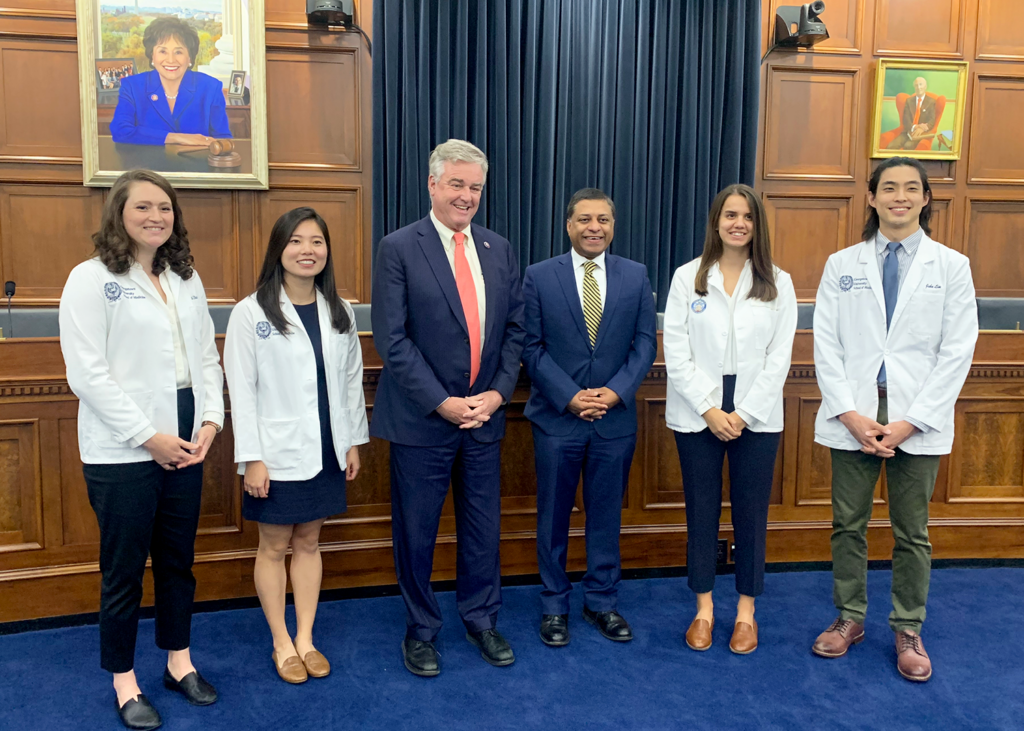Georgetown University School of Medicine students led a training for congressional staffers on Capitol Hill about the signs of opioid overdoses and ways to safely intervene through the Hoya Drug Overdose Prevention & Education (DOPE) Project.
The training for congressional staffers took place Sept. 28 and was led by members of the Hoya DOPE team in conjunction with the Bipartisan Addiction and Mental Health Task Force, represented by U.S. Representatives David Trone (D-Md), Annie Kuster (D-NH) and Paul Tonko (D-NY), as well as National Drug Control Policy Director Rahul Gupta. Leaders of the training instructed participants on how to recognize the signs of opioid overdoses and how to intervene with lifesaving overdose antidote naloxone.
The students that comprise the Hoya DOPE team engage in training various groups on lifesaving treatments for reversing opioid overdoses. 93,000 people died from opioid overdoses in 2020, setting a new record high, according to a 2022 Centers for Disease Control and Prevention (CDC) report. This year, the CDC has already recorded over 100,000 opioid related deaths.
In addition to the training given to congressional staffers, DOPE educates future physicians on how to best treat opioid use disorders and to improve patient care in the District, according to Kira Chandran (MED ’23), a member of DOPE.
“We believe that community access to naloxone and overdose education are important parts of reducing opioid-related morbidity and mortality in DC,” Chandran wrote to The Hoya. “There are many people who have put a lot of work into reducing opioid-related deaths in DC, and we hope that our small contribution helps make DC a healthier community.”
As they enter clinical rotations during their medical school training, Chandran said members of DOPE have personally witnessed the impact of opioid overdoses on D.C. residents.
“In addition to our experiences in the hospital and outpatient clinics, we were first responders to an opioid overdose last year on a side-walk in Ward 5 of DC,” Chandran wrote. “We had naloxone with us and we were able to reverse the overdose before EMTs arrived on the scene.”

DOPE was able to respond to the emergency because they are trained to recognize signs of overdose and because they carry naloxone on them, Chandran said.
Regina LaBelle, director of the Addiction and Public Policy Initiative at the O’Neill Institute, a research institute within the Georgetown University Law Center (GULC) focusing on national and global health law, said distributing and raising awareness for opioid treatment is particularly essential in the District.
“Given the high rate of overdose deaths in DC, it’s important that we all do our part to address this important issue,” LaBelle wrote to The Hoya. “The mission of our initiative is to advance evidence based policies to reduce overdose deaths and improve outcomes for people with substance use disorder.”
The opioid epidemic in D.C. has worsened in recent years, especially because of increased feelings of alienation due to the COVID-19 pandemic, according to Lawrence Gostin, faculty director of the O’Neill Institute.
“The O’Neill Institute believes that opioid and other drug dependencies are among the most urgent public health crises facing America. The suffering, loss, and death has only escalated during the COVID pandemic, when so many people felt alone and isolated,” Gostin wrote to The Hoya. “And yet this is largely a preventable problem.”
Gostin said despite an increase in overdose related deaths, it is possible to avoid opioid overdoses with the right health policy measures.
“We can dramatically reduce opioid use and overdose with evidence-based solutions,” Gostin wrote. “It is our job as a Georgetown University institute to use our skills in law, policy, and research to make a difference in the lives of so many American families.”
As part of its mission to address the District’s opioid crisis, the O’Neill Institute is advocating for legislative change that supports the direct efforts of organizations like Hoya DOPE, according to LaBelle.
“We’ve worked to encourage law enforcement in DC to carry naloxone; drafted model legislation which is currently before the DC City Council that will make certain that the proceeds of litigation brought against the opioid industry is used appropriately and expands access to evidence based policies; and removing legal and regulatory barriers that stand in the way of getting care to people in need,” LaBelle wrote.
The new legislation responds to the District’s past misspending of federal funds for naloxone distribution and harm reduction services. According to a 2018 Washington Post investigation, D.C.’s initiative provided naloxone kits at rates three to four times lower than peer cities with similar opioid problems.
As a part of the D.C. community, Georgetown holds an obligation to support the District in fighting the opioid crisis, Gostin said.
“The key points are that opioid use and overdose is among the most pressing health issues in America, but that there are clear policy steps we can take to save lives and reduce suffering among individuals, families, and communities,” Gostin wrote.





















nothoya25 • Oct 17, 2022 at 5:03 pm
Another excellent article written by Nina Raj